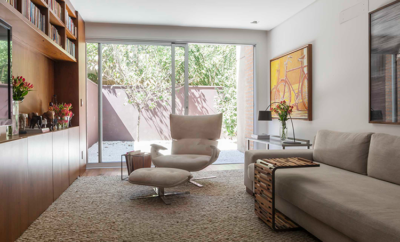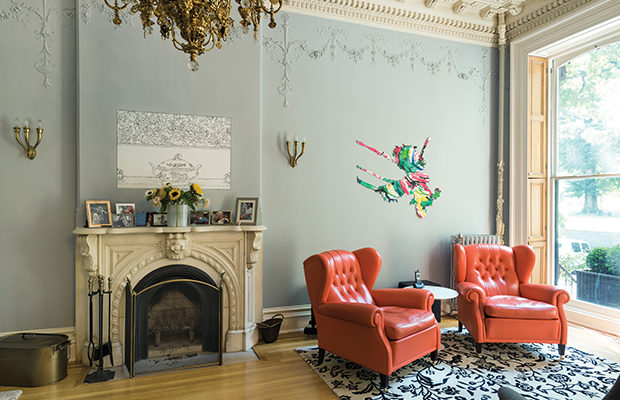
Design
Elective affinities
HOW IS CONTEMPORARY ART SHOWN to best advantage? Until recently, most people would have had only one answer for that question: against a white wall. Artworks look best when displayed in an otherwise blank space, with plenty of room to breathe.
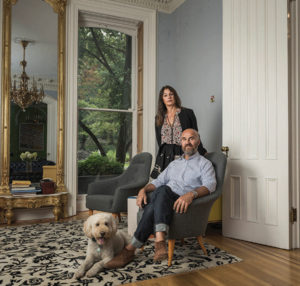
In the front parlor, Stefano Basilico sits in one of two Kerstin Horlin-Holmquist so-called Big Adam chairs while his wife, Janet Kraynak, stands behind him. Photography by Sasha Maslov.
It is easy to see why people like this uncluttered look. Any space can easily be converted to a gallery simply by throwing up some drywall and a lick of paint. Yet it can also express power, as in the expansive acreage of a highly capitalized Chelsea gallery. Architecturally speaking, the “white cube” is quite an invention. It is at once simple, authoritative, and supremely flexible.
Despite these advantages, however, we are currently experiencing a change in fashion, toward more complex mise-en-scènes. Where art starts and stops is no longer so sharply defined. These days, we often need to speak not of artworks, but of art situations.
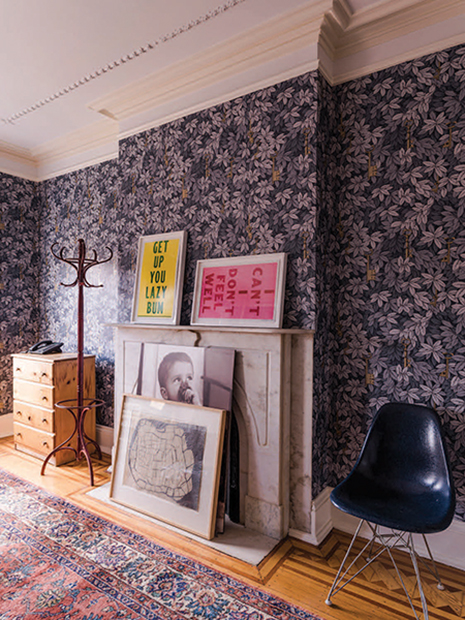
Terry Winters’s pencil drawing Untitled, 1994, leans in front of a fireplace in the fourth- floor guest room. On the mantel is Cary Leibowitz’s Get Up You Lazy Bum/I Can’t I Don’t Feel Well, 2005. To the right is a vintage Charles and Ray Eames fiberglass side chair with Ei el Tower base. The wallpaper is Cole and Son’s Chiavi Segrete, which is based on a pair of motifs by Piero Fornasetti. Photography by Sasha Maslov.
As a result, the display of art in domestic spaces—which rarely conform to the white cube formula—has come to seem more significant. It used to be that “decorating” with art was deeply suspect. The thinking was: a serious person doesn’t buy a painting because it goes with the living room sofa. This attitude ignored the fact that art perhaps looks best, and certainly means most, when it is integrated into everyday life. From this perspective, home is the ideal setting. Rather than seeing the domestic fabric as interfering with the autonomous artwork, we can understand it as an opportunity to generate fresh ways of looking, serendipitous adjacencies, and personal meanings that are every bit as relevant as grand art historical narratives.
In effect, this means thinking of the art collector as a kind of curator. Artist, collector, dealer, and curator are no longer fixed roles, but can be adopted as circumstance demands.
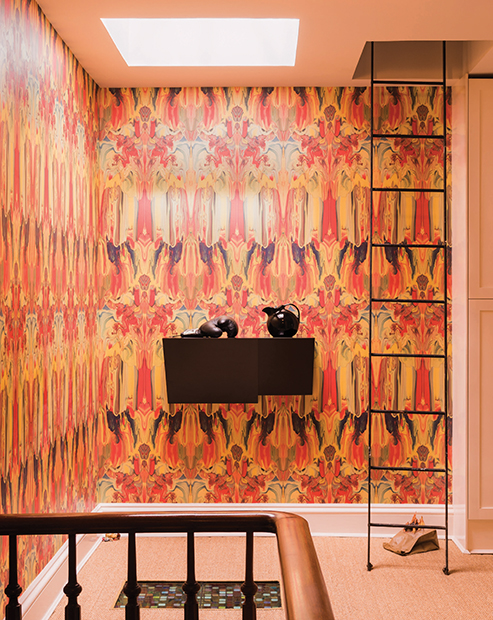
The wallpaper in the fifth-floor landing/hallway is Marble Gum by Timorous Beasties. Haim Steinbach’s ten second memos #8, 1991, hangs on the wall, and Bag of Shit on Fire, 1995, by Tony Matelli hides on the floor behind the ladder leading to the roof. Photography by Sasha Maslov.
With this background in mind, it is most interesting to step into the home of Stefano Basilico, Janet Kraynak, and their son, Giulio, located in Fort Greene, Brooklyn. Basilico has been working as an art adviser for the past decade or so, having previously been a museum curator; prior to that he worked in commercial galleries, operating his own space from 1993 to 1999. Kraynak is a prominent art historian who teaches at Columbia University, with particular expertise in the work of Bruce Nauman. (Giulio is thirteen years old and has yet to build a résumé in the arts, but given his parentage, one can expect great things.)
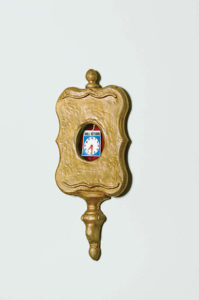
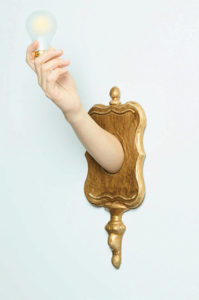
Ordinarily, Jamie Isenstein’s Magic Lamp, 2005, frames a hole in the wall, covered by a “will return by” sign. But sometimes the artist comes by for dinner parties to stick her arm through the hole, holding a cordless light bulb. Photography by Sasha Maslov.
The couple’s long exposure to the art world means that, in addition to having a great deal of expertise, they have also had many opportunities to acquire. They have bought consistently, sometimes when the artists concerned were early in their careers. This approach is in keeping with Basilico’s background as a dealer, which was adventurous and intentionally transient. Roberta Smith, writing in the New York Times in 1994, described his gallery as one of a number of smaller concerns that emerged in the wake of a collapse in the art market. These venues, she wrote, sought “low-cost ways to get the relatively inexpensive work of young or unknown artists before the public—if only for a few hours a week,” in the process “helping to redefine the way art is exhibited.”
Basilico and Kraynak’s collection has been built serendipitously, then, primarily via friendships and alliances. Even so, their multistory historic townhouse is quite a repository. Attached to the pieces are some blue-chip names—Cindy Sherman, Carroll Dunham, Wade Guyton—but there are also many fascinating works by lesser-known artists with a particular personal connection. It is also a curatorial exercise par excellence, rather like a permanent collection at a museum installed with unusual verve. One of the most telling features is that there is hardly a white wall anywhere.
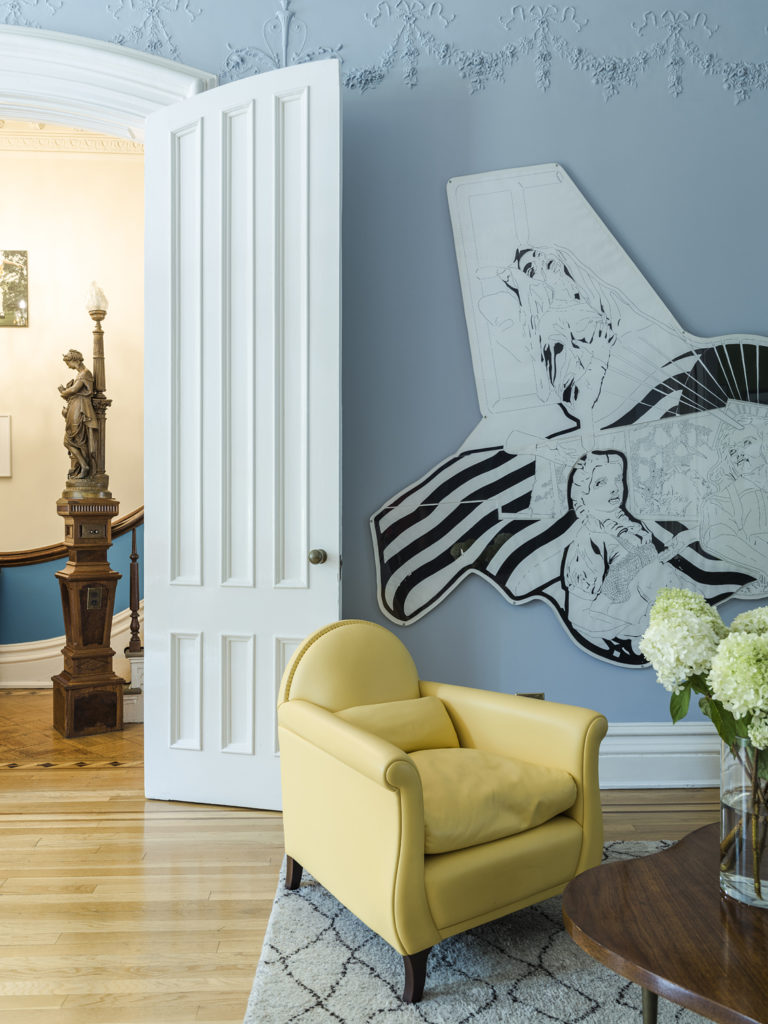
Bonnie Collura’s ink on paper Inalienable, 1999, hangs in the front parlor behind a Poltrona Frau Lyra armchair and T. H. Robsjohn-Gibbings biomorphic walnut table. Photography by Sasha Maslov.
The house was built in 1866, just after the cessation of the Civil War. It had been the beneficiary of benign neglect for most of its life, with original plasterwork, built-in cabinetry, and gasoliers spared from invasive redecoration. The structure had already been immaculately restored by a previous owner, who saw value in this Victorian survival, and the couple has enhanced the period look by selecting intense paint colors and wallpapers throughout. “These houses shouldn’t be white,” Basilico says. “It’s like you’re trying to make it look modern, and not in a good way.”
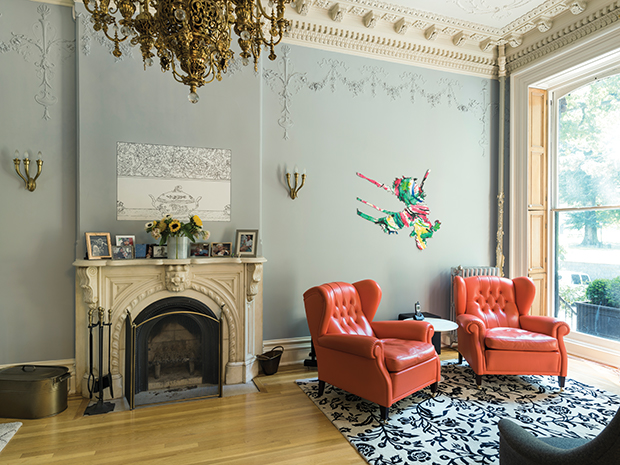
Above the mantel in the front parlor is Louise Lawler’s vinyl drawing Pollock and Tureen (traced), 1984–2013. On the wall behind two Poltrona Frau 1919 armchairs hangs Motif XV, 2011, a work on paper mounted on laser-cut aluminum by Cheyney Thompson. The sconces are by Gio Ponti, and the chandelier (which was once a gasolier) is original to the house. Photography by Sasha Maslov.
The most dramatic vignette, arguably, is all the way at the top of the house. A work by Haim Steinbach, the postmodernist sculptor well known for his arrangements of everyday consumer items on Formica-lined shelves, is set against a vibrant wallpaper by Timorous Beasties. The liquid pattern, somewhere between a marbled endpaper and a psychedelic poster from the Summer of Love, is an ideal counterpoint to Steinbach’s work, which is about the unstable status of the commodities it displays.
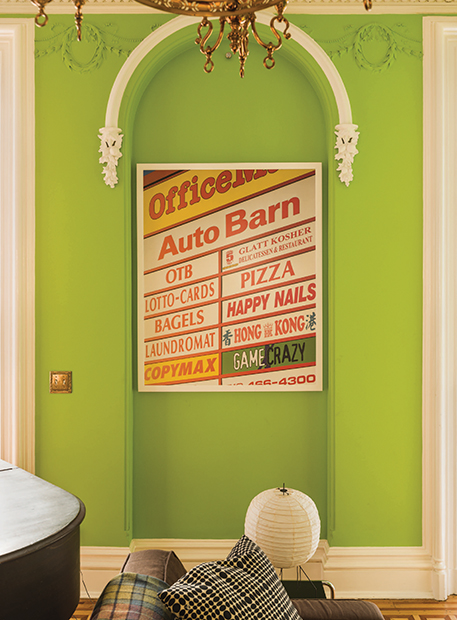
A photographic work by Roe Ethridge, Ceaderhurst Mall Sign, 2004, is displayed in a wall niche in the sitting room, or back parlor. Photography by Sasha Maslov.
Downstairs is quite theatrical, too. Basili- co has a passion for postwar design, a secondary base of connoisseurship that pays o in the lower-level dining room. Chiavari chairs (the vernacular inspiration for Gio Ponti’s iconic Superleggera) are gathered underneath a contemporary chandelier by Jason Miller. Among the artworks in the space is a conceptual installation by Jamie Isenstein. Usually, it is just a framed hole in the wall, covered by one of those “will return at . . .” signs that one occasionally sees hanging in the doors of lightly sta ed stores. But by arrangement, the artist occasionally comes by for dinner parties, sticks her arm through the hole, and holds a “magic” light bulb to illuminate the proceedings.

A vintage rosewood Thin Edge dresser by George Nelson stands under the painting Pink Sweep by Jon Pestoni, 2012, in the master bedroom. Photography by Sasha Maslov.
Pride of place in the house, as in Victorian times, goes to the parlor. It is tinted a relatively restrained gray-blue, all the better to set o the brightly colored furniture by Poltrona Frau. The space also leads to an adjoining sitting room, which has the couple’s boldest color choice, a green so intense that it prompts thoughts of the Incredible Hulk. It is a startlingly perfect backdrop for art, including a photographic work by Roe Ethridge depicting a strip-mall sign in glory.
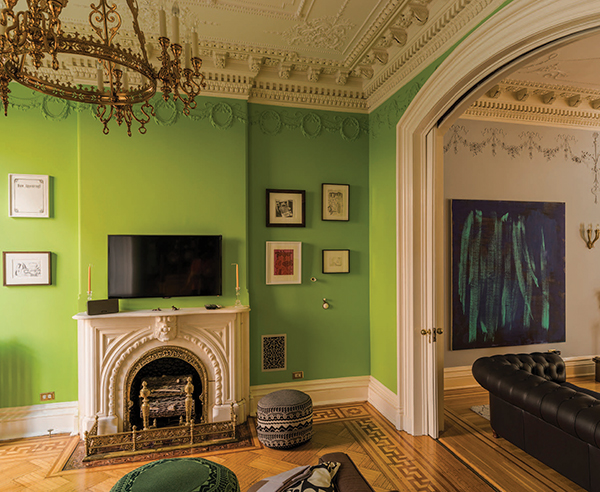
On the far wall in the back parlor are (far left, top to bottom) Jamie Isenstein’s watercolor Untitled, 2004, and Carroll Dunham’s ink- and-pencil on paper Untitled, 1990. On the other side of the TV and fireplace are (clockwise from top left) Matthew Antezzo’s pencil drawing Eleven O’Clock News Channel 4, 12/19/96, 1996; Dunham’s pencil drawing Untitled, 1993; Jennifer Bornstein’s copperplate etching Man Librarian, 2003; and Dunham’s linocut print Untitled, 1994. The Henry pouf (gray) and Frank pouf (green) are by Donna Wilson. Jon Pestoni’s oil on canvas Blue Sweep, 2011, is visible in the front parlor. A Poltrona Frau Chester One sofa curves out of the right side of the frame. Photography by Sasha Maslov.
Back in the parlor proper is one of the home’s cleverest curatorial moments. Above the mantelpiece is a Louise Lawler vinyl drawing depicting a tureen sitting under a Jackson Pollock painting. To the right is a gestural work by Cheyney Thompson, which itself plays on the legacy of Pollock’s drip paintings. Together, these works serve as a cue to the alert visitor that this is a house devoted to art, to living with art, and to thinking about what all that might mean.
Basilico and Kraynak owned most of their artworks before they owned this home, and they have never bought anything with thoughts of where they might hang it. There is a certain flexibility in their approach, even a certain indifference to the relative status of the artists whose works they’ve acquired. This may seem surprising in an art adviser and an art historian. But maybe if you work in those trades long enough you discover that value is not just where you find it, but what grows with you over time.

In the dining room, a chandelier and sconces from the Superordinate Antler collection by Jason Miller illuminate the Danish teak dining table and walnut Chiavari chairs made in Italy by Fratelli Levaggi, along with Brian Tolle’s Views from America’s Attic #6, a hand-colored black-and- white photograph. Photography by Sasha Maslov.
Gesturing at one point to a black plastic fan in the window, Basilico said to me, “that fan fits into life in a particular way. If it breaks, that creates a break in routine too.” Owning art is something like that, he seemed to imply. It is a matter of what one gets used to, what one would miss if it weren’t around anymore, what feels right as a part of each day. It’s as good a metric as any for understanding what it means to live with art.




